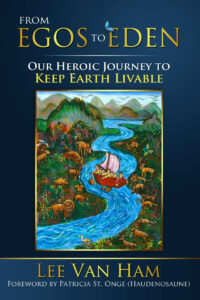By Lee Van Ham
The heavens declare the glory of God;
the skies proclaim the work of his hands.
Day after day they pour forth speech;
night after night they reveal knowledge.
They have no speech, they use no words;
no sound is heard from them.
Yet their voiceb] goes out into all the earth,
their words to the ends of the world. —Psalm 19:1-4 (the Bible’s cosmology)
“A human being is part of the whole called by us universe, a
part limited in time and space. We experience ourselves, our
thoughts and feelings as something separate from the rest. A
kind of optical delusion of consciousness. This delusion is a kind
of prison for us, restricting us to our personal desires and to
affection for a few persons nearest to us. Our task must be to
free ourselves from the prison by widening our circle of compassion
to embrace all living creatures and the whole of nature
in its beauty… We shall require a substantially new manner
of thinking if mankind [sic] is to survive.” (emphasis added)
—Albert Einstein (1875-1959)
(The abridged version as it appeared in the Monthly Review, New York, 1949)
[Note: The following is in From Egos to Eden, chapter 9, “From Taming the Wild to Rewilding Ourselves,” pages 267-269, which I completed in 2017.]
We will not succeed on our journey into the larger topographies of OneEarth consciousness without increased connections with the Wild. Henry David Thoreau opened others’ eyes to this essential connection when he structured his life to include experiences of wilderness. Far from escapism, his connection with Nature kept fresh his Call to a OneEarth world. Nature often elicited eloquent words from Thoreau as he explained why we humans cannot develop fully within the consciousness of civilization. In his essay “Simply Walking,” Thoreau wrote: “I wish to speak a word for Nature, for absolute Freedom and Wildness, as contrasted with a Freedom and Culture merely civil—to regard man as an inhabitant, or a part and parcel of Nature, rather than a member of society.” Such a sentence distinguishes how MultiEarth civilization seeks civil members of society” over the “absolute Freedom and Wildness” of OneEarth living. In the same essay, and in another strong claim for the priceless value of the Wild, Thoreau wrote, “In Wildness is the preservation of the world.” Wildness, far more than civilized prowess, has the capacity to reverse climate change and keep Earth livable.
Our national and state parks can arouse and animate these wild energies that Thoreau recognized we need for preservation, but only to a degree. Despite all there is to love about them, the parks also reinforce a chronic pathology of the MultiEarth paradigm: they separate humans from other species.
I came to understand this about our national parks after Juanita and I delighted in watching the six-episode PBS special, “The National Parks: America’s Best Idea, ” produced by documentarian Ken Burns and collaborator Dayton Duncan. It’s a rhapsody of Nature and urges viewers to a conscious recognition of the sacred in the Wild. It praises the embodiment of democracy in Nature. But it falls significantly short of the OneEarth paradigm’s understanding of our full relationship with Nature. I had missed this shortcoming until Scott Klinger, contributor to this book’s Chapter Seven, sent me an eye-opening email that included these words:
The national parks are a creation of the MultiEarth worldview. The MultiEarthers have divided the world into two pieces—the one to rape and pillage, and the other to maintain as pristine as possible. In the case of the national parks, “pristine” means without permanent human habitation. Most Indigenous Peoples I know have as negative a feeling about the parks as we white folks have a positive feeling for them. Not only were they displaced from the land which became the parks, but the U.S. government also turned the spaces sterile—banning the human species. There are not many places on earth where wilderness exists without human beings in it. Wilderness is not a place where humans don’t live: wilderness is a place where humans live in harmony with the earth.
First Peoples acted consistent with their worldview of shared relationship with Nature in 2014, when Yosemite National Park celebrated the 150th year since the signing of the Yosemite Grant Act, the precursor to its becoming a national park. Les James (Ahwahneeche), 79, and a tribal elder, said a blessing at an official ceremony in the Mariposa grove of sequoias, but he wasn’t celebrating. He had worked in the park most of his life, being among those determined to keep a First Peoples’ presence on that sacred land. But he also spoke candidly to the Sacramento Bee newspaper: “The changes, the destruction, that’s what I don’t like about it. You destroyed something that we preserved for thousands of years. In 150 years, you’ve ruined it.” (online Sacramento Bee newspaper, July 8, 2014)
Helen Coats (Ahwahneechee) is descended from the First Peoples who were living in Yosemite Valley the day the U.S. Mariposa Battalion drove them out and burned their village. She now lives along Highway 140, just outside the park, and feels sad as she sees busloads of tourists heading into the park every day. Words from her wounded heart tell us bluntly: “They are just trampling my home to death.” (same Sacramento Bee article as above) Can the pain of MultiEarth’s approach to the Wild, or the wounds it inflicts, be stated any more poignantly?






